
NBA Jam is a basketball video game developed and published by Midway for arcades in 1993. It is the first entry in the NBA Jam series. The project leader for this game was Mark Turmell.
A sports video game is a video game that simulates the practice of sports. Most sports have been recreated with video games, including team sports, track and field, extreme sports, and combat sports. Some games emphasize playing the sport, whilst others emphasize strategy and sport management. Some, such as Need for Speed, Arch Rivals and Punch-Out!!, satirize the sport for comic effect. This genre has been popular throughout the history of video games and is competitive, just like real-world sports. A number of game series feature the names and characteristics of real teams and players, and are updated annually to reflect real-world changes. The sports genre is one of the oldest genres in gaming history.
1993 saw many sequels and prequels in video games, such as Dragon Ball Z: Super Butōden, Mortal Kombat II, Secret of Mana, and Super Street Fighter II, alongside new titles such as Star Fox, FIFA International Soccer, Doom, Gunstar Heroes, Myst, Samurai Shodown, Ridge Racer, NBA Jam, Disney's Aladdin, and Virtua Fighter.

NBA Street is a basketball video game developed by NuFX and EA Canada and published by Electronic Arts under the EA Sports BIG label. It was released for the PlayStation 2 on June 19, 2001, and on February 5, 2002, for the GameCube. The game combines the talent and big names of the NBA with the attitude and atmosphere of streetball.

FIFA International Soccer is a 1993 association football video game developed by EA Canada's Extended Play Productions team and published by Electronic Arts. The game was released for the Sega Mega Drive/Genesis console in December 1993 and ported to numerous other systems in 1994. It is the first game in the FIFA series.
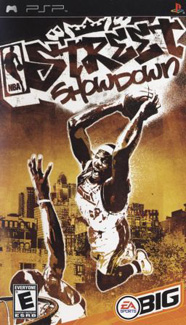
NBA Street Showdown is a basketball video game developed by Canadian studio Team Fusion and published by Electronic Arts under the EA Sports BIG label. It is the fourth installment in the NBA Street series, and a handheld port of NBA Street V3. The game was released on April 25, 2005, in North America, on September 1, 2005, in Europe, and on September 29, 2005, in Japan, for the PlayStation Portable.
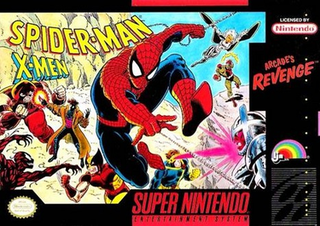
Spider-Man and the X-Men in Arcade's Revenge is a video game released for the Super NES in 1992 by LJN. It was released for the Genesis and Game Gear as well as the Game Boy. The game features Marvel Comics characters Spider-Man and the X-Men as they battle their captor, the villainous Arcade to escape Murderworld.
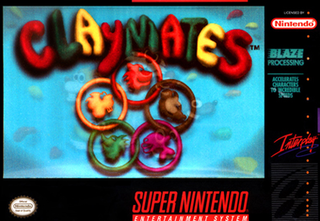
Claymates is a platform game for the Super Nintendo Entertainment System (SNES). It is one of Interplay's clay animation titles which also included the ClayFighter series.

Kobe Bryant in NBA Courtside, sometimes mislabeled as Kobe Bryant's NBA Courtside, is a basketball simulation video game developed by Left Field Productions and published by Nintendo for the Nintendo 64 in 1998. At the time of the game's release, Kobe Bryant was in his second NBA season and at age 19, was the youngest player to have a game named for him. It was followed by a sequel, NBA Courtside 2: Featuring Kobe Bryant, released in 1999.

NBA In The Zone '98 is a basketball game for the Nintendo 64 and PlayStation. It was released in 1998 and developed and published by Konami. It is the third installment of the NBA In The Zone series. The cover features Glen Rice of the Charlotte Hornets.
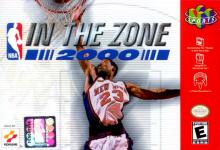
NBA In The Zone 2000 is a basketball video game released for the Nintendo 64, PlayStation, and Game Boy Color in 2000. It is the fifth and final installment of the NBA In The Zone series. The cover features Marcus Camby of the New York Knicks.
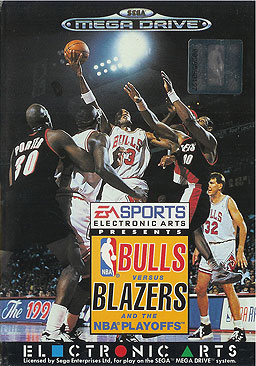
Bulls vs. Blazers and the NBA Playoffs, later released in Japan as NBA Pro Basketball: Bulls vs Blazers and the NBA Playoffs, is a 1993 basketball video game produced by Don Traeger and developed by Electronic Arts and released for the Super Nintendo Entertainment System. A later Mega Drive version was released under the title Bulls versus Blazers and the NBA Playoffs, later released in Japan as NBA Playoffs: Bulls vs Blazers.

NHL '94 is an ice hockey game by EA Sports for the Genesis, Super NES, and Sega CD, as well as the first release for the PC (DOS), simply titled "NHL Hockey", without the "94" in the title. The game is officially licensed from the National Hockey League and the NHL Players' Association, and was the first game in the series to have both combined licenses. The third game in the NHL series media franchise, it was released in September 1993 for the Sega Genesis and November 1993 for the Super Nintendo. NHL '94 launched to critical acclaim, and it has since been referred to as both the greatest sports game of all time as well as one of the best games ever made.
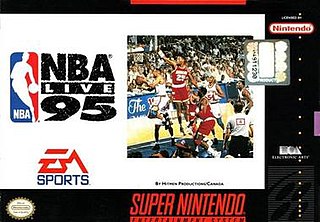
NBA Live 95 is the follow-up to NBA Showdown and the first NBA Live title in the NBA Live video games series from EA Sports. It was published by EA Sports and released in October 1994. The cover features an action shot from the 1994 NBA Finals.
The 1993–94 NBA season was the Pacers' 18th season in the National Basketball Association, and 27th season as a franchise. The Pacers would undergo several changes as the club hired Larry Brown as head coach, acquired Derrick McKey from the Seattle SuperSonics, and signed free agent Haywoode Workman in the off-season. In December, the team signed free agent Byron Scott, who won championships with the Los Angeles Lakers in the 1980s. The Pacers got off to a rough start losing six of their first seven games, then later lost five straight in December leading to a 10–16 start. However, the team posted a 7-game winning streak between January and February, holding a 23–23 record at the All-Star break, and would play .500 ball until April. By winning their final eight games of the season, the Pacers were able to grab the #5 seed in the Eastern Conference and close out the season with a 47–35 record, fourth in the Central Division.
The 1993–94 NBA season was the Nuggets' 18th season in the National Basketball Association, and 27th season as a franchise. The Nuggets had the ninth overall pick in the 1993 NBA draft, and selected Rodney Rogers out of Wake Forest University. During the off-season, the team acquired Brian Williams from the Orlando Magic, then during the first month of the regular season, they traded Mark Macon and Marcus Liberty to the Detroit Pistons in exchange for All-Star guard Alvin Robertson. However, Robertson never played for the Nuggets due to a back injury, and was out for the entire season. The Nuggets played around .500 all season long with a 22–25 record at the All-Star break, and finished fourth in the Midwest Division with a 42–40 record and made the playoffs for the first time in four years. The Nuggets qualified for the playoffs as the #8 seed in the Western Conference.
The 1992–93 NBA season was the Jazz's 19th season in the National Basketball Association, and 14th season in Salt Lake City, Utah. During the off-season, the Jazz acquired Jay Humphries and Larry Krystkowiak from the Milwaukee Bucks. Salt Lake City hosted the 1993 NBA All-Star Game at the Delta Center, and their star players Karl Malone and John Stockton were both selected, and were both named co-MVPs. Malone and Stockton both continued to be among the best players in the NBA, as the Jazz won six of their first eight games on their way to a 24–10 start. However, they struggled down the stretch with a 6–8 record in February, including a five-game losing streak between February and March. The Jazz held a 33–18 record at the All-Star break, but would play below .500 for the remainder of the season. During the final month of the regular season, the team signed free agent James Donaldson, who played in the final six games. The Jazz finished third in the Midwest Division with a 47–35 record. They made their tenth consecutive trip to the playoffs.
The 1993–94 NBA season was the Hawks' 45th season in the National Basketball Association, and 26th season in Atlanta. In the off-season, Chicago Bulls All-Star guard Michael Jordan shocked the NBA by announcing his retirement. This meant that various teams in the league had an opportunity to contend for a championship. The Hawks hired Hall of Famer Lenny Wilkens as their new head coach. Wilkens was a star guard for the franchise when it was based in St. Louis in the 1960s. He was quickly moving up the all-time coaching wins list after successful runs with the Seattle SuperSonics and Cleveland Cavaliers. Wilkens employed a defensive system which benefited several members of the team. The team also signed free agents Craig Ehlo, and Andrew Lang during the off-season.
The 1993–94 NBA season was the sixth season for the Miami Heat in the National Basketball Association (NBA). During the off-season, the Heat signed free agent 7' 7" center Manute Bol, but released him to free agency after only just eight games. Led by the scoring and shooting of Glen Rice and Steve Smith, and the rebounding of Rony Seikaly, the Heat got off to a 16–13 start before losing seven straight games afterward in January and held a 23–24 record at the All-Star break. However, they would post a 7-game winning streak between February and March, but would then lose 13 of their final 18 games, finishing the regular season fourth in the Atlantic Division with their first winning record at 42–40. The Heat went on to make their second playoff appearance earning the #8 seed in the Eastern Conference.
The 1993–94 NBA season was the Warriors' 48th season in the National Basketball Association, and their 31st in the San Francisco Bay Area. In the 1993 NBA draft, the Warriors selected Penny Hardaway from the University of Memphis with the third overall pick, but soon traded him to the Orlando Magic in exchange for top draft pick Chris Webber from the University of Michigan. During the off-season, the team signed free agent Avery Johnson. Without All-Star guard Tim Hardaway and sixth man Šarūnas Marčiulionis, who both missed the entire season with knee injuries, and with Chris Mullin missing the first 20 games with a finger injury, the Warriors struggled losing three of their first four games, but soon recovered later holding a 27–20 record at the All-Star break. The team improved over the previous season as they posted an 8-game winning streak in April, finishing third in the Pacific Division with a solid 50–32 record.












